The Impact of Culture on Professional Practice Nursing Essay
VerifiedAdded on 2023/02/02
|6
|1175
|68
Essay
AI Summary
This essay explores the significant impact of culture on professional nursing practice. It begins by defining culture and its relevance in healthcare settings, emphasizing the importance of cultural awareness, sensitivity, and competence. The main body analyzes how cultural factors, including language barriers and communication styles, influence the nurse-patient relationship and overall healthcare outcomes. It discusses the differences between professional and community cultures, and how these differences affect nursing practice. Various organizational cultures, such as clan, advocacy, market, and hierarchy cultures are also discussed, highlighting the need for nurses to adapt to these environments. The essay also references the integrative communication model and cross-culture theory, offering insights into how healthcare organizations can manage cultural diversity and improve communication. The author shares personal experiences of cultural differences in a healthcare setting, and the importance of training to address these challenges. The conclusion reiterates the significance of cultural competence and the need for ongoing training to navigate cultural complexities in healthcare.
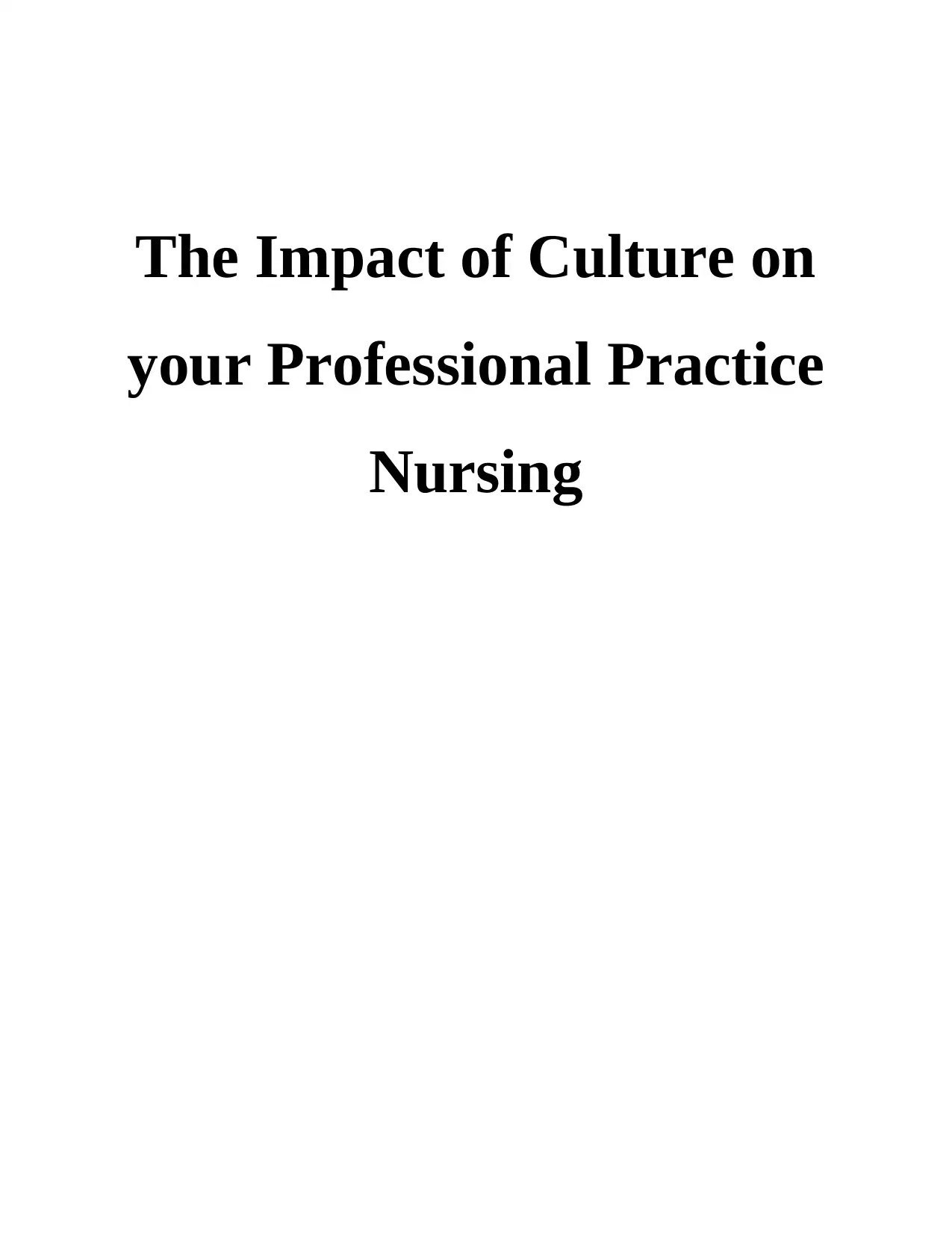
The Impact of Culture on
your Professional Practice
Nursing
your Professional Practice
Nursing
Paraphrase This Document
Need a fresh take? Get an instant paraphrase of this document with our AI Paraphraser

Table of Contents
INTRODUCTION...........................................................................................................................1
MAIN BODY...................................................................................................................................1
CONCLUSION................................................................................................................................3
REFERENCES................................................................................................................................1
INTRODUCTION...........................................................................................................................1
MAIN BODY...................................................................................................................................1
CONCLUSION................................................................................................................................3
REFERENCES................................................................................................................................1
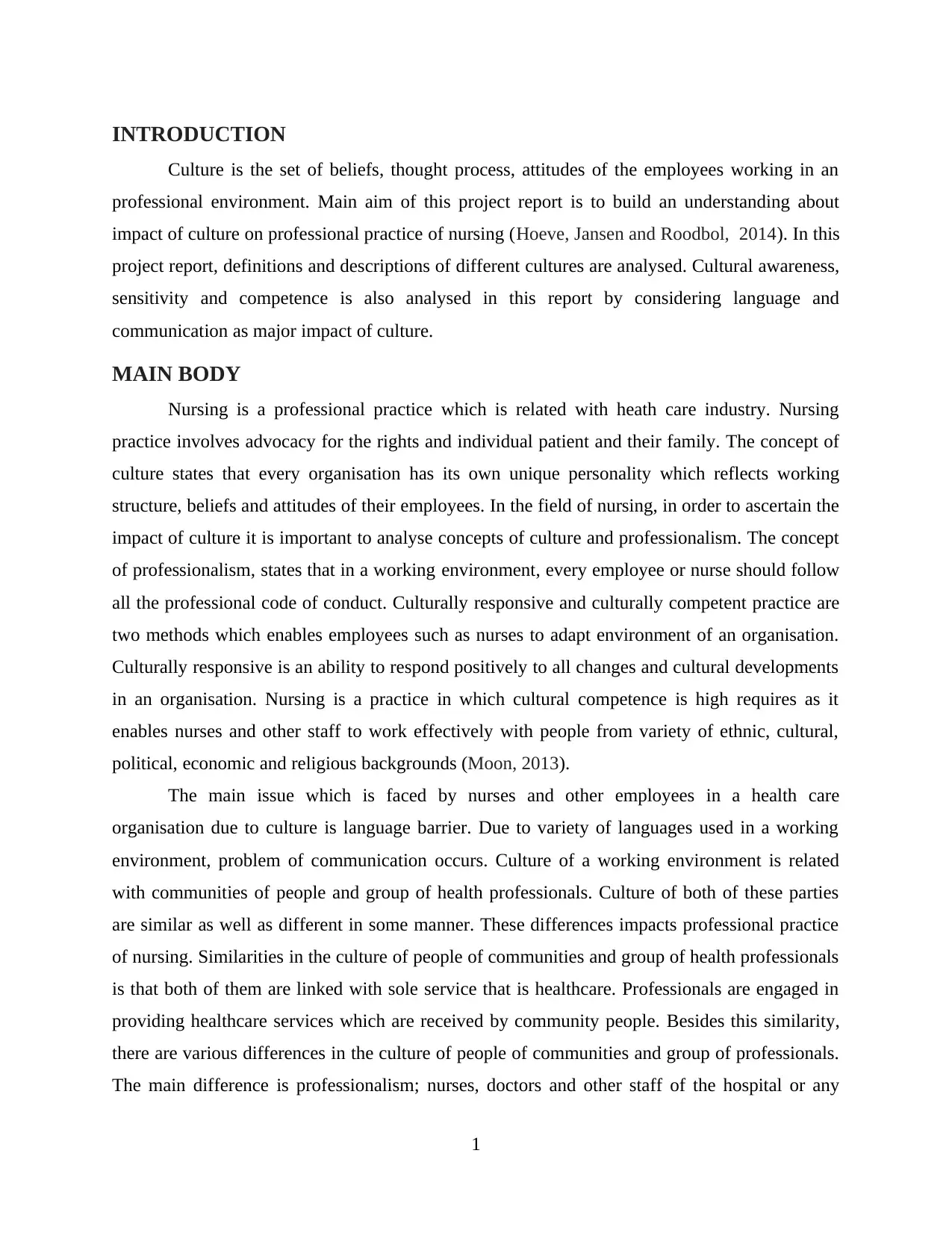
INTRODUCTION
Culture is the set of beliefs, thought process, attitudes of the employees working in an
professional environment. Main aim of this project report is to build an understanding about
impact of culture on professional practice of nursing (Hoeve, Jansen and Roodbol, 2014). In this
project report, definitions and descriptions of different cultures are analysed. Cultural awareness,
sensitivity and competence is also analysed in this report by considering language and
communication as major impact of culture.
MAIN BODY
Nursing is a professional practice which is related with heath care industry. Nursing
practice involves advocacy for the rights and individual patient and their family. The concept of
culture states that every organisation has its own unique personality which reflects working
structure, beliefs and attitudes of their employees. In the field of nursing, in order to ascertain the
impact of culture it is important to analyse concepts of culture and professionalism. The concept
of professionalism, states that in a working environment, every employee or nurse should follow
all the professional code of conduct. Culturally responsive and culturally competent practice are
two methods which enables employees such as nurses to adapt environment of an organisation.
Culturally responsive is an ability to respond positively to all changes and cultural developments
in an organisation. Nursing is a practice in which cultural competence is high requires as it
enables nurses and other staff to work effectively with people from variety of ethnic, cultural,
political, economic and religious backgrounds (Moon, 2013).
The main issue which is faced by nurses and other employees in a health care
organisation due to culture is language barrier. Due to variety of languages used in a working
environment, problem of communication occurs. Culture of a working environment is related
with communities of people and group of health professionals. Culture of both of these parties
are similar as well as different in some manner. These differences impacts professional practice
of nursing. Similarities in the culture of people of communities and group of health professionals
is that both of them are linked with sole service that is healthcare. Professionals are engaged in
providing healthcare services which are received by community people. Besides this similarity,
there are various differences in the culture of people of communities and group of professionals.
The main difference is professionalism; nurses, doctors and other staff of the hospital or any
1
Culture is the set of beliefs, thought process, attitudes of the employees working in an
professional environment. Main aim of this project report is to build an understanding about
impact of culture on professional practice of nursing (Hoeve, Jansen and Roodbol, 2014). In this
project report, definitions and descriptions of different cultures are analysed. Cultural awareness,
sensitivity and competence is also analysed in this report by considering language and
communication as major impact of culture.
MAIN BODY
Nursing is a professional practice which is related with heath care industry. Nursing
practice involves advocacy for the rights and individual patient and their family. The concept of
culture states that every organisation has its own unique personality which reflects working
structure, beliefs and attitudes of their employees. In the field of nursing, in order to ascertain the
impact of culture it is important to analyse concepts of culture and professionalism. The concept
of professionalism, states that in a working environment, every employee or nurse should follow
all the professional code of conduct. Culturally responsive and culturally competent practice are
two methods which enables employees such as nurses to adapt environment of an organisation.
Culturally responsive is an ability to respond positively to all changes and cultural developments
in an organisation. Nursing is a practice in which cultural competence is high requires as it
enables nurses and other staff to work effectively with people from variety of ethnic, cultural,
political, economic and religious backgrounds (Moon, 2013).
The main issue which is faced by nurses and other employees in a health care
organisation due to culture is language barrier. Due to variety of languages used in a working
environment, problem of communication occurs. Culture of a working environment is related
with communities of people and group of health professionals. Culture of both of these parties
are similar as well as different in some manner. These differences impacts professional practice
of nursing. Similarities in the culture of people of communities and group of health professionals
is that both of them are linked with sole service that is healthcare. Professionals are engaged in
providing healthcare services which are received by community people. Besides this similarity,
there are various differences in the culture of people of communities and group of professionals.
The main difference is professionalism; nurses, doctors and other staff of the hospital or any
1
⊘ This is a preview!⊘
Do you want full access?
Subscribe today to unlock all pages.

Trusted by 1+ million students worldwide
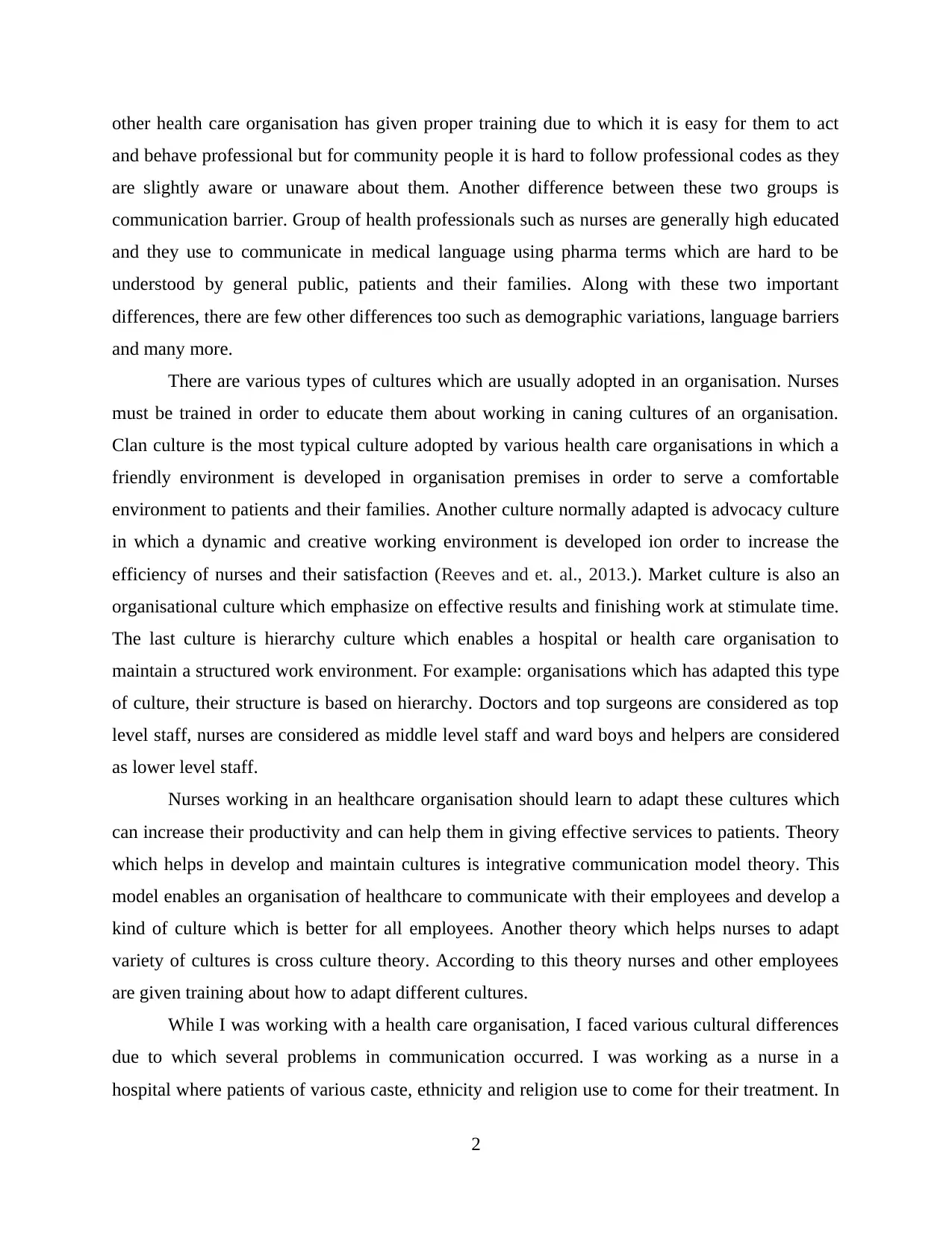
other health care organisation has given proper training due to which it is easy for them to act
and behave professional but for community people it is hard to follow professional codes as they
are slightly aware or unaware about them. Another difference between these two groups is
communication barrier. Group of health professionals such as nurses are generally high educated
and they use to communicate in medical language using pharma terms which are hard to be
understood by general public, patients and their families. Along with these two important
differences, there are few other differences too such as demographic variations, language barriers
and many more.
There are various types of cultures which are usually adopted in an organisation. Nurses
must be trained in order to educate them about working in caning cultures of an organisation.
Clan culture is the most typical culture adopted by various health care organisations in which a
friendly environment is developed in organisation premises in order to serve a comfortable
environment to patients and their families. Another culture normally adapted is advocacy culture
in which a dynamic and creative working environment is developed ion order to increase the
efficiency of nurses and their satisfaction (Reeves and et. al., 2013.). Market culture is also an
organisational culture which emphasize on effective results and finishing work at stimulate time.
The last culture is hierarchy culture which enables a hospital or health care organisation to
maintain a structured work environment. For example: organisations which has adapted this type
of culture, their structure is based on hierarchy. Doctors and top surgeons are considered as top
level staff, nurses are considered as middle level staff and ward boys and helpers are considered
as lower level staff.
Nurses working in an healthcare organisation should learn to adapt these cultures which
can increase their productivity and can help them in giving effective services to patients. Theory
which helps in develop and maintain cultures is integrative communication model theory. This
model enables an organisation of healthcare to communicate with their employees and develop a
kind of culture which is better for all employees. Another theory which helps nurses to adapt
variety of cultures is cross culture theory. According to this theory nurses and other employees
are given training about how to adapt different cultures.
While I was working with a health care organisation, I faced various cultural differences
due to which several problems in communication occurred. I was working as a nurse in a
hospital where patients of various caste, ethnicity and religion use to come for their treatment. In
2
and behave professional but for community people it is hard to follow professional codes as they
are slightly aware or unaware about them. Another difference between these two groups is
communication barrier. Group of health professionals such as nurses are generally high educated
and they use to communicate in medical language using pharma terms which are hard to be
understood by general public, patients and their families. Along with these two important
differences, there are few other differences too such as demographic variations, language barriers
and many more.
There are various types of cultures which are usually adopted in an organisation. Nurses
must be trained in order to educate them about working in caning cultures of an organisation.
Clan culture is the most typical culture adopted by various health care organisations in which a
friendly environment is developed in organisation premises in order to serve a comfortable
environment to patients and their families. Another culture normally adapted is advocacy culture
in which a dynamic and creative working environment is developed ion order to increase the
efficiency of nurses and their satisfaction (Reeves and et. al., 2013.). Market culture is also an
organisational culture which emphasize on effective results and finishing work at stimulate time.
The last culture is hierarchy culture which enables a hospital or health care organisation to
maintain a structured work environment. For example: organisations which has adapted this type
of culture, their structure is based on hierarchy. Doctors and top surgeons are considered as top
level staff, nurses are considered as middle level staff and ward boys and helpers are considered
as lower level staff.
Nurses working in an healthcare organisation should learn to adapt these cultures which
can increase their productivity and can help them in giving effective services to patients. Theory
which helps in develop and maintain cultures is integrative communication model theory. This
model enables an organisation of healthcare to communicate with their employees and develop a
kind of culture which is better for all employees. Another theory which helps nurses to adapt
variety of cultures is cross culture theory. According to this theory nurses and other employees
are given training about how to adapt different cultures.
While I was working with a health care organisation, I faced various cultural differences
due to which several problems in communication occurred. I was working as a nurse in a
hospital where patients of various caste, ethnicity and religion use to come for their treatment. In
2
Paraphrase This Document
Need a fresh take? Get an instant paraphrase of this document with our AI Paraphraser
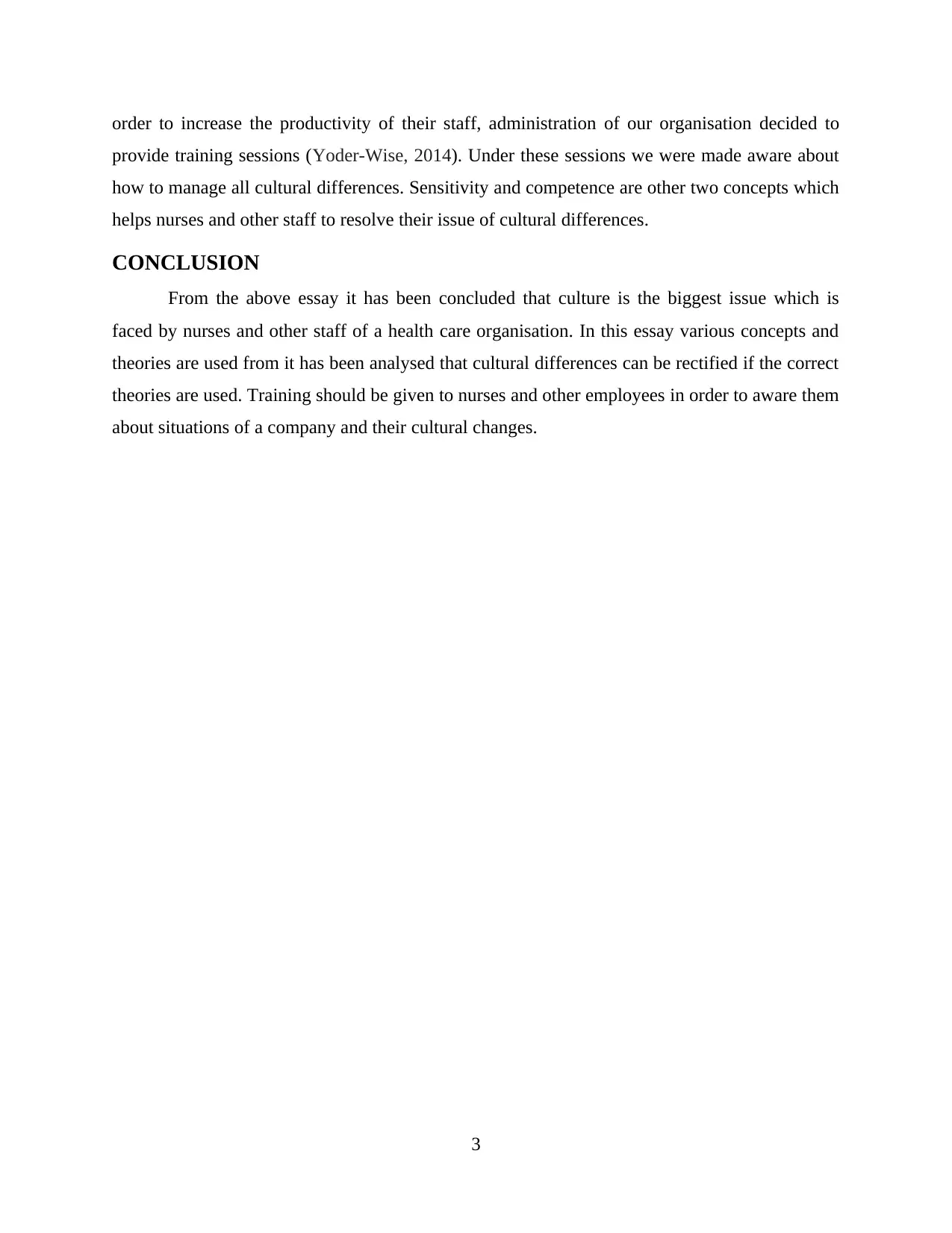
order to increase the productivity of their staff, administration of our organisation decided to
provide training sessions (Yoder-Wise, 2014). Under these sessions we were made aware about
how to manage all cultural differences. Sensitivity and competence are other two concepts which
helps nurses and other staff to resolve their issue of cultural differences.
CONCLUSION
From the above essay it has been concluded that culture is the biggest issue which is
faced by nurses and other staff of a health care organisation. In this essay various concepts and
theories are used from it has been analysed that cultural differences can be rectified if the correct
theories are used. Training should be given to nurses and other employees in order to aware them
about situations of a company and their cultural changes.
3
provide training sessions (Yoder-Wise, 2014). Under these sessions we were made aware about
how to manage all cultural differences. Sensitivity and competence are other two concepts which
helps nurses and other staff to resolve their issue of cultural differences.
CONCLUSION
From the above essay it has been concluded that culture is the biggest issue which is
faced by nurses and other staff of a health care organisation. In this essay various concepts and
theories are used from it has been analysed that cultural differences can be rectified if the correct
theories are used. Training should be given to nurses and other employees in order to aware them
about situations of a company and their cultural changes.
3
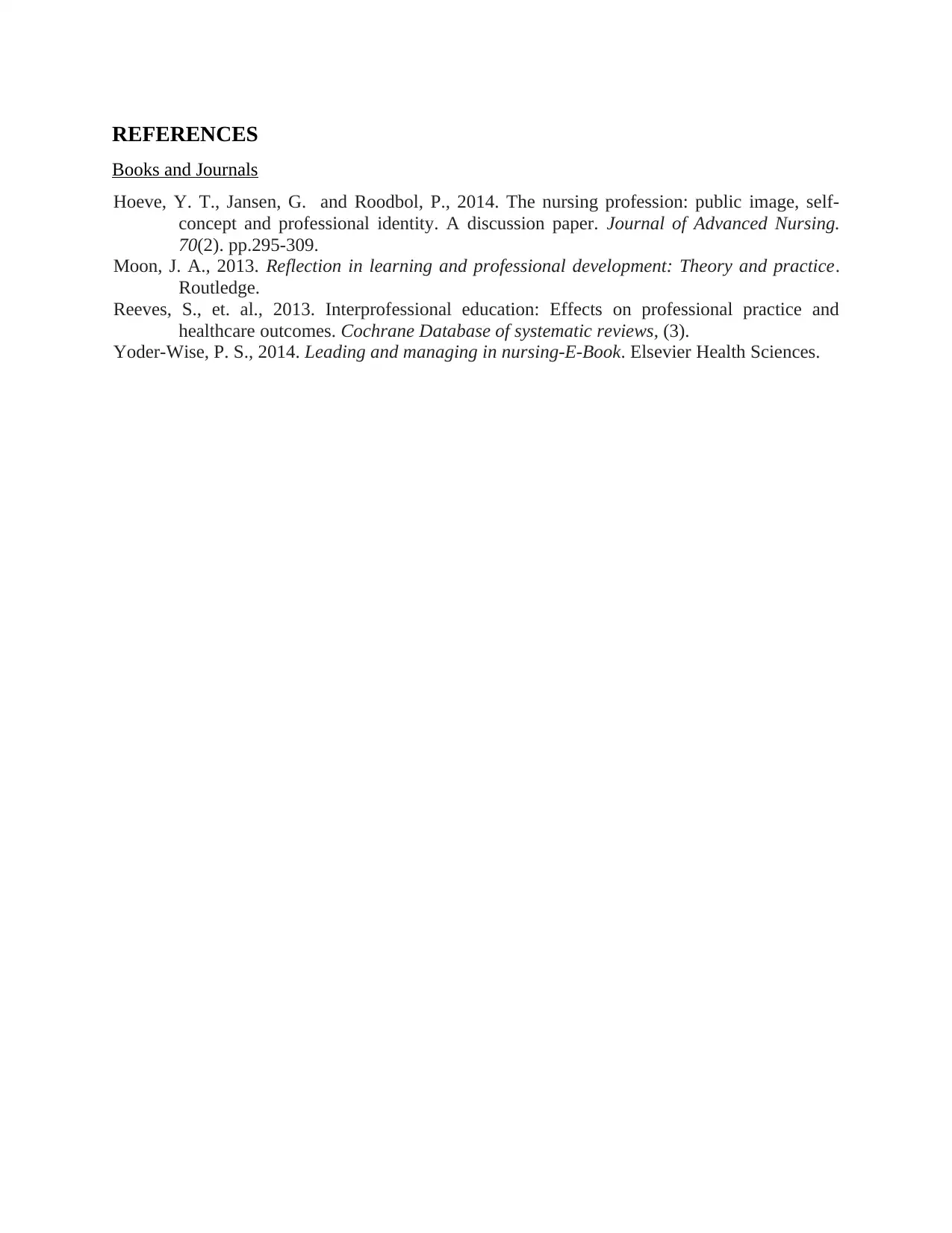
REFERENCES
Books and Journals
Hoeve, Y. T., Jansen, G. and Roodbol, P., 2014. The nursing profession: public image, self‐
concept and professional identity. A discussion paper. Journal of Advanced Nursing.
70(2). pp.295-309.
Moon, J. A., 2013. Reflection in learning and professional development: Theory and practice.
Routledge.
Reeves, S., et. al., 2013. Interprofessional education: Effects on professional practice and
healthcare outcomes. Cochrane Database of systematic reviews, (3).
Yoder-Wise, P. S., 2014. Leading and managing in nursing-E-Book. Elsevier Health Sciences.
Books and Journals
Hoeve, Y. T., Jansen, G. and Roodbol, P., 2014. The nursing profession: public image, self‐
concept and professional identity. A discussion paper. Journal of Advanced Nursing.
70(2). pp.295-309.
Moon, J. A., 2013. Reflection in learning and professional development: Theory and practice.
Routledge.
Reeves, S., et. al., 2013. Interprofessional education: Effects on professional practice and
healthcare outcomes. Cochrane Database of systematic reviews, (3).
Yoder-Wise, P. S., 2014. Leading and managing in nursing-E-Book. Elsevier Health Sciences.
⊘ This is a preview!⊘
Do you want full access?
Subscribe today to unlock all pages.

Trusted by 1+ million students worldwide
1 out of 6
Related Documents
Your All-in-One AI-Powered Toolkit for Academic Success.
+13062052269
info@desklib.com
Available 24*7 on WhatsApp / Email
![[object Object]](/_next/static/media/star-bottom.7253800d.svg)
Unlock your academic potential
Copyright © 2020–2025 A2Z Services. All Rights Reserved. Developed and managed by ZUCOL.





